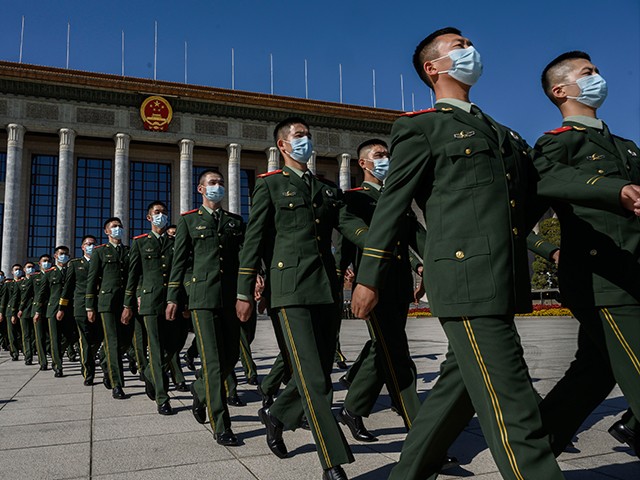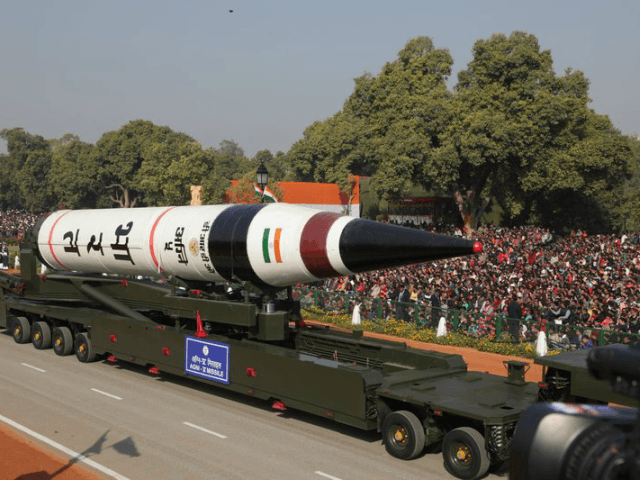India on Wednesday conducted a test launch of its Agni-5 missile, a nuclear-capable weapon whose 3,125-mile range is sufficient to hit any potential target in China.
According to the Indian government, the test missile landed with a “very high degree of accuracy” in the Bay of Bengal.
Indian officials said the test was conducted as part of India’s policy to maintain “credible minimum deterrence” and restated India’s commitment to avoid using first-strike tactics.
A spokesperson for the Indian Defense Ministry said the Agni-5 is “capable of neutralizing targets threatening India’s sovereignty and territorial integrity.”
Virtually all outside observers read the missile test as a response to China’s recent actions, particularly last week’s report that Beijing tested a surprisingly advanced hypersonic missile in August and/or China’s failure to resolve its border dispute with India, which began a year and a half ago with a brutal hand-to-hand skirmish in the Himalayan valley of Galwan.

An Indian army convoy drives towards Leh, on a highway bordering China, on June 19, 2020, in Gagangir, India, following the “violent face-off” with Chinese troops in the Galwan Valley along the Himalayas. (Yawar Nazir/Getty Images)
An editorial at the Hindustan Times on Thursday linked India’s missile test to China’s hypersonic missile launch, portraying the Agni-5 as a component of New Delhi’s response to China’s “Sputnik moment” – a phrase employed by U.S. Chairman of the Joint Chiefs of Staff Gen. Mark Milley. The Economic Times of India also thought India “should be worried” about China’s hypersonic weapon.
Nikkei Asia noted the Agni series of missiles was “conceptualized in the 1980s with threats from neighboring Pakistan and China in mind,” and the Agni-5 has previously been tested successfully, so Wednesday evening’s test launch was probably intended to send a message to Beijing.
Al Jazeera pointed out that India already has the capability to strike targets anywhere in Pakistan with smaller missiles, so the intended audience for the Agni-5 launch was most likely in China. Al Jazeera added China’s growing assertiveness in the Indian Ocean as another reason why India might want to demonstrate its missile capabilities.
Around the same time it was conducting its missile test, India expressed concerns about a combative “land borders law” passed by China’s rubber-stamp legislature, the National People’s Congress, on Saturday.
The law is essentially a formal threat by China to use military force against any party that “undermines territorial sovereignty and land boundaries.” Chinese political and military leaders say such things all the time, but it is unusual for the National People’s Congress to codify the threats in law.

Chinese soldiers from the People’s Liberation Army wear protective masks as they march after a ceremony marking the 70th anniversary of China’s entry into the Korean War, on October 23, 2020, at the Great Hall of the People in Beijing, China. (Kevin Frayer/Getty Images)
The legislation was clearly aimed at intimidating India, as the only other neighbor currently locked in a heated border dispute with China is tiny Bhutan. China has disputed Bhutan’s claims to about 200 square miles along the border since the 1980s. The Bhutanese were annoyed to discover Chinese villages sprouting on the turf claimed by Bhutan in 2015.
The Chinese were trying to do much the same thing to India in the Himalayas last year when the infamous Galwan Valley brawl broke out. Indian officials are worried that China will invoke the new “land borders law” to declare itself legally obligated to fight over every bit of Himalayan territory China has claimed with boot, stick, or brick.
“China’s unilateral decision to bring about a legislation which can have implications on our existing bilateral arrangements on border management as well as on the boundary question is of concern to us,” the Indian Foreign Ministry said.
“Multiple rounds of talks, whether it is at the diplomatic or military level between the two countries have made virtually no progress in overcoming the impasse. The new law indicates a hardening of position, it aims to show that China is powerful,” cautioned Rajeswari Pillai Rajagopalan, director of New Delhi’s Center for Security, Strategy, and Technology.

COMMENTS
Please let us know if you're having issues with commenting.